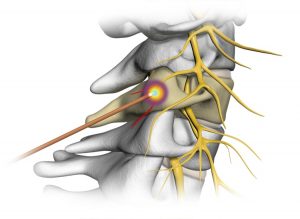Cervical Radiculopathy
What is Cervical Radiculopathy?
Some people have neck pain that may radiate into the shoulder and arm. This type of pain is often caused by an injury near the root of a spinal nerve. A nerve root injury is sometimes referred to as a “pinched” nerve. The medical term for this condition is cervical radiculopathy.
Causes of Cervical Radiculopathy
As disks in the spine age, they lose height and begin to bulge. They also lose water content and become stiffer and the vertebrae move closer together. The uneven pressure being put on the spine joints, called facets, become arthritic and start to have bone growth — called spurs — around the disk to strengthen it. The bone spurs that form also contribute to the stiffening of the spine. Bone spurs may also cause a condition called foraminal stenosis by narrowing the area of the foramen and pinch the nerve root.
The disk changes that occur with age are often called arthritis or spondylosis. It is important to keep in mind that all these changes are “normal” and they occur in everyone. In fact, if MRI scans were performed on all people aged 50 or older, nearly half of the scans would show worn disks and pinched nerves that do not cause painful symptoms. The cause of cervical radiculopathy that causes some patients to have symptoms and others not is unknown.
Symptoms of Cervical Radiculopathy
Cervical radiculopathy pain travels down the arm in the area of the involved nerve. Pain is usually described as sharp. There can also be a “pins and needles” sensation or even complete numbness. In addition, there may be a feeling of weakness with certain activities.
Symptoms of cervical radiculopathy can be worsened with certain movements, like extending or straining the neck or turning the head. These symptoms are often made better by placing the hand on the head and stretching the shoulder.
Nonsurgical and Surgical Treatment Options
It is important to note that the majority of patients with cervical radiculopathy get better with time and never even require treatment or surgery at all.
Some patients will notice their pain deminishing quickly over a matter of days, while others take much longer to notice any relief. It is also not uncommon for cervical radiculopathy to come back at some time in the future, but again, this problem usually gets better without any specific treatment. Some patients do develop persistent symptoms, and require evaluation and treatment for the arm pain or weakness.
If you are not getting better, your surgeon will recommend a course of treatment. Treatment for radiculopathy starts with nonsurgical options.
Nonsurgical treatment may consists of using soft collars to allow the muscles of the neck to rest and limit neck motion. This can help decrease pinching of nerve roots with movement. Soft collars should only be worn for short periods of time, because long-term use can decrease the strength of neck muscles.
Other nonsurgical treatments consists of physical therapy to help with neck muscle stretching and strengthening, or simply taking medications. Some examples of medication treatment are as followed:
- Nonsteroidal anti-inflammatories (NSAIDS): These include drugs like aspirin and ibuprofen, and may be helpful if the arm symptoms are from nerve swelling
- Oral corticosteroids: A short course of oral corticosteroids may also help reduce swelling, as well as pain
- Narcotics: These medications are reserved for patients with severe pain that is not relieved by other options. Narcotics are usually prescribed for a limited time only
- Spinal injections: Sometimes an injection of steroids can be placed near where the nerve is being pinched. This takes advantage of the anti-inflammatory effects similar to oral steroids. The injection may be placed between the laminae (epidural steroid injection), in the foramen (selective nerve injection), or into the facet joint. While steroid injections do not take the pressure caused by a narrow foramen or herniated disk off the nerve, they may lessen the swelling and relieve the pain enough to allow the nerve to recover with more time
If Nonsurgical treatment isn’t right for you, there are several surgical procedures for radiculopathy. The procedure that is right for you will depend on many factors, most importantly the type of problem you have.
Click here to find an orthopedic spine specialist right for you
F.A.Q.
How long does it take for someone to get better after having cervical radiculopathy?
The time it takes to recover from cervical radiculopathy depends on the ailment’s seriousness and the selected treatment. In less complex situations, the symptoms might go away entirely in weeks. Recovery could take a few months or even longer when the condition is more serious.
Is it possible to avoid getting cervical radiculopathy?
There is no foolproof method for preventing cervical radiculopathy; however, practicing excellent posture, engaging in regular exercise, and avoiding activities such as heavy lifting and engage in movements that are performed repetitively will help minimize the risk.


